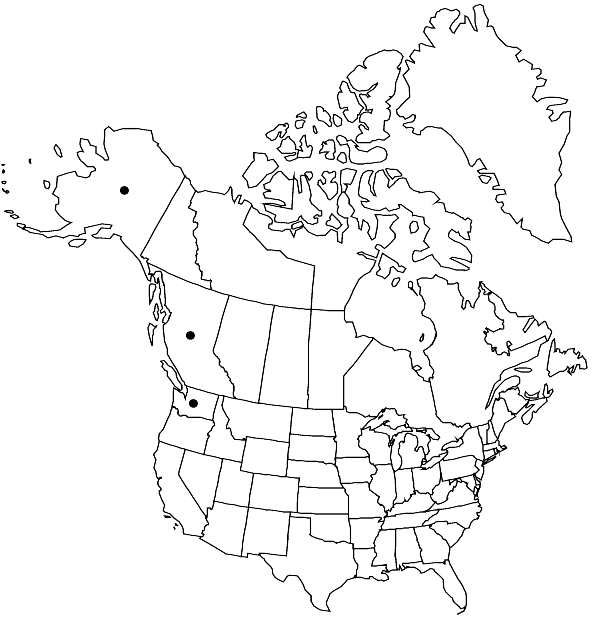Difference between revisions of "Sphagnum alaskense"
Bryologist 106: 435, figs. 1, 3. 2003,.
FNA>Volume Importer |
imported>Volume Importer |
||
| (6 intermediate revisions by 2 users not shown) | |||
| Line 21: | Line 21: | ||
|elevation=low to moderate elevations | |elevation=low to moderate elevations | ||
|distribution=B.C.;Alaska;Wash. | |distribution=B.C.;Alaska;Wash. | ||
| − | |discussion=<p>Sphagnum alaskense most resembles S. magellanicum and S. centrale in its chorophyll cell cross section. The cross section characteristic is most similar to that of S. centrale but S. alaskense lacks thickened walls. Sphagnum alaskense also apparently does not have any range overlap with S. centrale, the latter being more of a boreal forest species. Sphagnum alaskense occurs in more open and less mineral rich sites near the coast. Sphagnum magellanicum has more well-enclosed chlorophyll cells and usually has some purplish coloration, whereas S. alaskense often has a quite distinctive pinkish brown color which, along with its often large flattened capitula, can give it a distinctive look in the field.</p> | + | |discussion=<p><i>Sphagnum alaskense</i> most resembles <i>S. magellanicum</i> and <i>S. centrale</i> in its chorophyll cell cross section. The cross section characteristic is most similar to that of <i>S. centrale</i> but <i>S. alaskense</i> lacks thickened walls. <i>Sphagnum alaskense</i> also apparently does not have any range overlap with <i>S. centrale</i>, the latter being more of a boreal forest species. <i>Sphagnum alaskense</i> occurs in more open and less mineral rich sites near the coast. <i>Sphagnum magellanicum</i> has more well-enclosed chlorophyll cells and usually has some purplish coloration, whereas <i>S. alaskense</i> often has a quite distinctive pinkish brown color which, along with its often large flattened capitula, can give it a distinctive look in the field.</p> |
|tables= | |tables= | ||
|references= | |references= | ||
| Line 30: | Line 30: | ||
-->{{#Taxon: | -->{{#Taxon: | ||
name=Sphagnum alaskense | name=Sphagnum alaskense | ||
| − | |||
|authority=R. E. Andrus & Janssens | |authority=R. E. Andrus & Janssens | ||
|rank=species | |rank=species | ||
| Line 44: | Line 43: | ||
|publication year= | |publication year= | ||
|special status= | |special status= | ||
| − | |source xml=https:// | + | |source xml=https://bitbucket.org/aafc-mbb/fna-data-curation/src/2e0870ddd59836b60bcf96646a41e87ea5a5943a/coarse_grained_fna_xml/V27/V27_9.xml |
|genus=Sphagnum | |genus=Sphagnum | ||
|section=Sphagnum sect. Sphagnum | |section=Sphagnum sect. Sphagnum | ||
Latest revision as of 21:29, 5 November 2020
Plants moderate-sized to robust, ± weak-stemmed and compact, capitulum conspicuously large and flat-topped; pinkish brown to red-brown; compact low hummocks and hummock sides. Stems brown, superficial cortical layer with spiral reinforcing fibrils lacking or faint, usually 2 or more pores per cell, comb-fibrils lacking on interior wall. Stem leaves to 1.7 × 1.2 mm; rarely hemiisophyllous; hyaline cells nonseptate to occasionally septate, comb-lamellae absent. Branches long and tapering. Branch fascicles with 2 spreading and 2 pendent branches. Branch stems with hyaline cells non-ornamented, no or weak funnel-like projections on the interior end walls, often with large round pores on the superficial wall. Branch leaves broadly ovate, to 3 × 2.3 mm; hyaline cells on proximal half of convex surface with elliptical pores along the commissures, often with ridges running parallel to long leaf axis on hyaline cell surface overlying chlorophyllous cells; chlorophyllous cells elliptical and just enclosed on both surfaces in transverse section; end walls not thickened. Sexual condition dioicous. Capsule not seen. Spores unknown.
Habitat: Poor to medium fens and mineral edges of ombrotrophic mires
Elevation: low to moderate elevations
Distribution

B.C., Alaska, Wash.
Discussion
Sphagnum alaskense most resembles S. magellanicum and S. centrale in its chorophyll cell cross section. The cross section characteristic is most similar to that of S. centrale but S. alaskense lacks thickened walls. Sphagnum alaskense also apparently does not have any range overlap with S. centrale, the latter being more of a boreal forest species. Sphagnum alaskense occurs in more open and less mineral rich sites near the coast. Sphagnum magellanicum has more well-enclosed chlorophyll cells and usually has some purplish coloration, whereas S. alaskense often has a quite distinctive pinkish brown color which, along with its often large flattened capitula, can give it a distinctive look in the field.
Selected References
None.